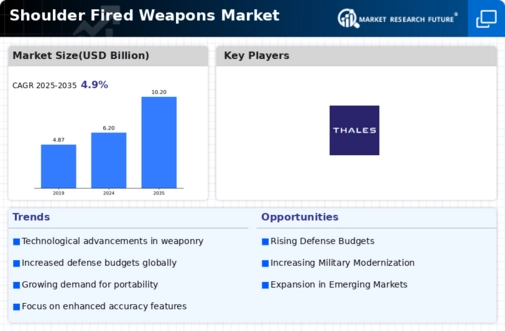Top Industry Leaders in the Shoulder Fired Weapons Market

Strategies Adopted:
Technological Advancements: Key players focus on developing advanced shoulder-fired weapons with improved accuracy, range, lethality, and reduced weight to enhance operational effectiveness and meet evolving customer requirements.
Customization and Modularity: Offering modular designs and customizable features allows companies to tailor weapons to specific mission requirements, increase user versatility, and attract a broader customer base.
International Collaboration: Collaborating with international partners and defense agencies enables companies to access new markets, share development costs, and leverage complementary technologies, driving market expansion and competitiveness.
After-Sales Support: Providing comprehensive after-sales support, including maintenance, repair, and training services, enhances customer satisfaction, fosters long-term relationships, and promotes repeat business and loyalty.
Key Companies in the Shoulder-fired Weapons market include
Denel Soc Ltd
JSC KBM
KBP Instrument Design Bureau
Lockheed Martin Corporation
MBDA Holdings SAS
Rafael Advanced Defense Systems Ltd
Raytheon Company
Roketsan AS
Saab AB
Thales Group
Factors for Market Share Analysis:
Performance and Reliability: Market share analysis considers the performance, reliability, and durability of shoulder-fired weapons, including accuracy, range, lethality, recoil management, and resistance to environmental conditions.
Affordability and Cost-Effectiveness: The affordability and cost-effectiveness of weapons, including acquisition costs, lifecycle costs, and operational expenses, influence market share by addressing budget constraints and cost-benefit considerations.
User Experience: Market share is influenced by user experience factors, such as ergonomics, ease of operation, training requirements, and user feedback, reflecting user satisfaction levels and adoption rates.
Export and Licensing Agreements: The number and value of export and licensing agreements with foreign governments, military forces, and international organizations impact market share by expanding market reach and revenue opportunities.
Industry News:
Anti-Tank Missile Development: Industry news highlights ongoing developments in anti-tank missile systems, including next-generation guided missiles, multi-role capabilities, and advanced seeker technologies, to counter emerging threats and enhance battlefield effectiveness.
Lightweight Materials: Companies invest in lightweight materials, such as composite materials, carbon fiber, and advanced alloys, to reduce weapon weight, improve portability, and enhance soldier mobility and maneuverability.
Counter-Drone Systems: Integration of shoulder-fired weapons with counter-drone systems, including kinetic kill solutions and electronic warfare capabilities, addresses the growing threat posed by hostile unmanned aerial vehicles (UAVs) on the battlefield.
Precision-Guided Munitions: Advancements in precision-guided munitions, including laser-guided rockets and smart grenades, offer enhanced accuracy and effectiveness against a wide range of targets, increasing demand for shoulder-fired weapons with integrated precision capabilities.
Current Company Investment Trends:
Research and Development: Companies allocate significant investments towards research and development (R&D) activities to drive innovation, develop new technologies, and maintain a competitive edge in the market.
International Expansion: Strategic investments in international marketing, sales, and distribution networks enable companies to expand market presence, establish partnerships, and capitalize on global defense procurement opportunities.
Digital Transformation: Investments in digital technologies, including simulation, modeling, and virtual testing, streamline product development processes, improve manufacturing efficiency, and reduce time-to-market for new shoulder-fired weapons.
Sustainability Initiatives: Increasing focus on sustainability initiatives, such as reducing carbon footprint, minimizing environmental impact, and promoting ethical business practices, aligns with corporate social responsibility goals and enhances brand reputation and customer appeal.
Shoulder-fired Weapons Industry Developments
For instance May 2022, Lockheed Martin has planned to aim around nearly double the production of a Javelin anti-tank shoulder-fired weapon from 2,100 annually to 4000 annually. At the same time, the US army also planned to purchase 1,300 stinger man-portable anti-tank systems from Lockheed-Raytheon joint venture.
For instance April 2022, the US army released a request for RFI to the industry as part of its replacing its stockpiles of FIM-92 Stinger MANPADS with new similar functioning missiles.












